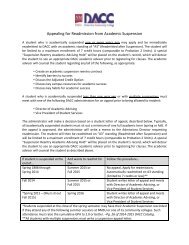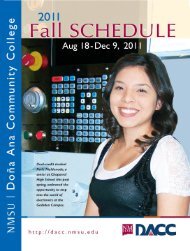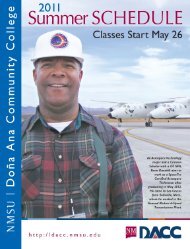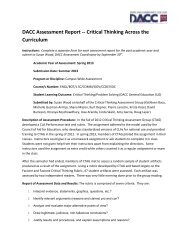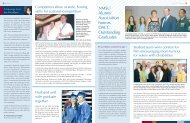DACC Catalog - Dona Ana Community College - New Mexico State ...
DACC Catalog - Dona Ana Community College - New Mexico State ...
DACC Catalog - Dona Ana Community College - New Mexico State ...
Create successful ePaper yourself
Turn your PDF publications into a flip-book with our unique Google optimized e-Paper software.
2012-2013 <strong>Catalog</strong> 57Associate Degree (66 credits)Core Requirements23 creditsengl 111g Rhetoric and Composition 4engl 203g Business and Professional Communication 3ororenglengl211G218gWriting in the Humanities and Social SciencesTechnical and Scientific Communicationcomm 253g Public Speaking3or comm 265g Principles of Human Communicationchem 110g Principles and Applications of Chemistry 4math 210g Mathematics Appreciation 3psy 201g Introduction to Psychology 3soc 101g Introductory Sociology 3Related Requirementsorspanspan111113Elementary Spanish I (4)Spanish for Heritage Speakers I (3)3–4 credits3–4Technical Requirements39–40 creditsNOTE: Some of the following courses may have prerequisites found in the “LevelingCourses” section.C J 101g Introduction to Criminal Justice 3C J 205 Criminal Law I 3C J 210 American Law Enforcement Systems 3C J 221 Fundamentals of Criminal Investigations 3C J 250 Courts and the Criminal Justice System 3lawe 201 Introduction to Juvenile Delinquency 3lawe 202 Police Patrol Procedures 3lawe 205 Practical Field Investigations 3lawe 207 Legal Aspects of Law Enforcement 3fire 226 Fire Investigations II 3Electives chosen in consultation with advisor9–10(Leveling course can be used to fulfill this requirement.)Fire Science TechnologyAssociate of Applied Science DegreeCertificate of Completion: Basic Firefighter (COSTS LISTED ON PAGE 12)(575) 527-7746 or 528-7247NOTE: This program does not emphasize firefighter operations. Instead,it focuses on theory, investigation, prevention, and management. Studentswishing to enter the fire service may benefit from the general backgroundprovided and may receive Firefighter I certification through the <strong>New</strong> <strong>Mexico</strong>Firefighters Training Academy in Socorro, N.M.Every year, fire and other emergencies take thousands of lives and destroyproperty worth billions of dollars. Firefighters help protect the public againstthese dangers. They are frequently the first emergency personnel at thescene of a traffic accident or medical emergency and may be called upon toput out a fire, treat injuries, or perform other vital functions.Firefighters work in a wide variety of settings, including urban and suburbanareas, airports, chemical plants and other industrial sites, and such ruralareas as wildlands and forests. When wildland fires break out, crews of firefightersare brought in to suppress the fires with heavy equipment and handtools. In addition, smoke jumpers parachute into inaccessible areas. Otherswho have been trained for the control, prevention, and cleanup of hazardousmaterials incidents work in hazardous materials units.Between alarms, firefighters clean and maintain equipment, conduct practicedrills and fire inspections, and participate in physical fitness activities.They also prepare written reports on fire incidents and review fire scienceliterature to keep abreast of technological developments and changing administrativepractices and policies.Most fire departments have a fire prevention division, usually headed by afire marshal and staffed by fire inspectors. Workers in this division conductinspections of structures to prevent fire and ensure fire code compliance.These firefighters also work with developers and planners to check and approveplans for new buildings. Fire prevention personnel often speak onthese subjects in schools and before public assemblies and civic organizations.Employment of firefighters is expected to grow about as fast as the averagefor all occupations through 2012, as fire departments continue to competewith other public safety providers for funding. According to the United<strong>State</strong>s Fire Administration, nearly 70 percent of fire companies are staffed byvolunteer firefighters. Most job growth will occur as volunteer fire-fightingpositions are converted to paid positions. In addition to job growth, openingsare expected to result from the need to replace firefighters who retire,stop working for other reasons, or transfer to other occupations.Doña <strong>Ana</strong> <strong>Community</strong> <strong>College</strong> provides training for firefighting personnelthrough its Fire Science Technology program, which is accredited by theInternational Fire Service Accreditation Congress. This program providesclassroom instruction leading to an associate of applied science degree infire science technology or a certificate of completion in firefighting. It issuited to those who are new to the field, as well as seasoned firefighters:• Career and volunteer firefighters and NMSU student firefighters willimprove their job performance and prepare for higher level positionsin the fire protection fields.• Students who wish to enter the field of fire protection will benefitfrom the basic foundations provided in the technical courses as wellas general education courses.NOTE: An articulation agreement exists with the <strong>New</strong> <strong>Mexico</strong> FirefightersTraining Academy that makes it possible to receive college credit for experienceand IFSAC certification. All courses in this program may be appliedtoward a Bachelor of Applied Studies or Bachelor of Individualized Studiesdegree at NMSU.Students must receive a C or better in each course in order for it to applytoward graduation.Medical Clearances and Background ChecksThe basic firefighter course requires the student to submit a medical clearancephysical and a background check.NOTE: A criminal history may prohibit graduates from being hired or certifiedby agencies. Students are encouraged to check with the prospectiveagency and identify that agency’s specific requirements prior to enrollingin this program.Required Skills and AbilitiesPhysical AbilitiesThis program requires that the student be able to—• lift, carry and balance up to 125 pounds (250 pounds with assistance)• assume a variety of postural positions and be capable of physical maneuversranging from crawling, kneeling, squatting, twisting, turning,and bending, to climbing stairs and ladders)• withstand varied environmental conditions such as extreme heat,cold, and moisture.



